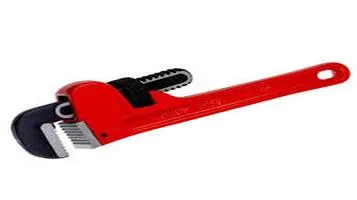Pipe Wrench – The Essential Tool for Plumbing and Beyond
A pipe wrench is a robust hand tool designed specifically for gripping and turning pipes and pipe fittings. Typically made from durable steel or aluminum, it features an adjustable jaw mechanism that allows it to securely grasp cylindrical objects of various sizes. The wrench’s serrated jaws offer a firm grip, minimizing slippage and enhancing torque application during operations. Commonly used in plumbing and pipe installation tasks, pipe wrenches are indispensable for assembling or disassembling threaded pipes. They come in various sizes, catering to different pipe dimensions and tasks, with the traditional straight pipe wrench being the most common type. Additionally, its ergonomic handle provides comfort and leverage, making it an essential tool for both professional plumbers and DIY enthusiasts tackling home improvement projects.

Introduction
The pipe wrench is an iconic tool, often synonymous with the plumbing profession. As a versatile and indispensable instrument, its robust design and functionality make it invaluable not only to plumbers but to a wide array of professionals and DIY enthusiasts. This review will delve into the features, advantages, limitations, and overall utility of the pipe wrench, providing a comprehensive analysis of its performance in various scenarios.
Design and Build Quality
At first glance, the pipe wrench exudes ruggedness. Typically constructed from sturdy materials like cast iron or aluminum, its design emphasizes durability and strength. The tool features an adjustable jaw, allowing it to grip pipes of different diameters securely. The handle is often long and ergonomically designed to provide ample leverage, making it easier to turn even the most stubborn pipes.
The jaws are serrated, providing a firm grip on smooth or greasy surfaces, which is a common challenge in plumbing tasks. The self-tightening mechanism ensures that the wrench grips tighter as more torque is applied, preventing slippage and reducing the risk of damaging the pipe. High-quality pipe wrenches also incorporate a replaceable hook jaw, heel jaw, and spring assembly, extending the tool's lifespan.
Performance and Versatility
The performance of a pipe wrench is remarkable in its primary domain of plumbing. Whether it’s loosening a rusty old pipe or tightening a new installation, the pipe wrench performs with commendable efficacy. Its ability to adjust quickly to different pipe sizes makes it a versatile tool in both residential and commercial plumbing projects.
Beyond plumbing, the pipe wrench proves useful in various other applications. Mechanics might find it handy for working on large bolts and nuts, while metalworkers can use it for holding and manipulating metal components. The tool's simplicity and reliability make it a go-to for tasks requiring a strong, adjustable grip.
Ease of Use
Using a pipe wrench is relatively straightforward, which adds to its appeal for both professionals and amateurs. Adjusting the jaw width is as simple as turning a knurled nut, and the long handle provides sufficient leverage to make even the most challenging tasks manageable. The ergonomic handle design minimizes user fatigue, allowing for prolonged use without discomfort.
However, it’s important to note that using a pipe wrench effectively does require some practice. Ensuring the jaws are properly aligned and applying the right amount of pressure is crucial to avoid slipping and potential damage to the pipe. For beginners, it might take a few tries to get the hang of it, but once mastered, the pipe wrench becomes an incredibly efficient tool.
Limitations
While the pipe wrench is incredibly versatile, it does have some limitations. Its design is optimized for round objects like pipes, so it may not be suitable for flat or irregularly shaped objects. Additionally, the serrated jaws, while excellent for gripping, can damage softer materials. It's crucial to use the right tool for the job to avoid unnecessary damage.
Another consideration is the weight. Cast iron pipe wrenches, in particular, can be quite heavy, which might not be ideal for tasks requiring extended use or for individuals with less upper body strength. Aluminum versions are lighter and easier to handle but can be more expensive.
Maintenance and Longevity
Maintaining a pipe wrench is relatively easy. Regular cleaning to remove dirt and debris from the jaws and adjusting mechanism will keep it in good working order. Lubricating the adjustment nut and moving parts periodically will ensure smooth operation and prevent rust. Given that high-quality pipe wrenches have replaceable parts, it’s possible to keep a single tool serviceable for many years, making it a cost-effective investment.
Value for Money
In terms of value for money, the pipe wrench stands out. Its durability and wide range of applications mean that you're likely to get extensive use out of it for many years. While there are cheaper tools available, investing in a high-quality pipe wrench from a reputable brand is advisable, as it will perform better and last longer.
Conclusion
The pipe wrench is a quintessential tool that has stood the test of time. Its robust design, versatility, and ease of use make it a staple in any toolkit, whether for professional plumbers, mechanics, or DIY enthusiasts. While it has some limitations, its benefits far outweigh them, making it an excellent addition to any collection of tools.
In summary, the pipe wrench is not just a tool; it’s an investment in reliability and performance. Whether you're tackling a major plumbing project or just need a reliable grip for a stubborn bolt, the pipe wrench is sure to deliver with flying colors. If you don’t already own one, it’s high time to consider adding this indispensable tool to your arsenal.






